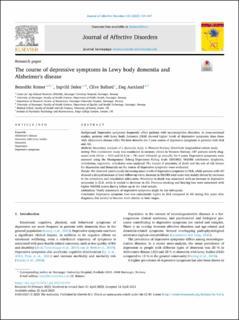| dc.contributor.author | Römer, Benedikt Carl Gustav | |
| dc.contributor.author | Dalen, Ingvild | |
| dc.contributor.author | Ballard, Clive | |
| dc.contributor.author | Aarsland, Dag | |
| dc.date.accessioned | 2023-06-26T11:12:44Z | |
| dc.date.available | 2023-06-26T11:12:44Z | |
| dc.date.created | 2023-06-05T13:52:16Z | |
| dc.date.issued | 2023 | |
| dc.identifier.citation | Römer, B., Dalen, I., Ballard, C., & Aarsland, D. (2023). The course of depressive symptoms in Lewy body dementia and Alzheimer's disease. Journal of Affective Disorders, 333, 459-467. | en_US |
| dc.identifier.issn | 0165-0327 | |
| dc.identifier.uri | https://hdl.handle.net/11250/3073203 | |
| dc.description.abstract | Background
Depressive symptoms frequently affect patients with neurocognitive disorders. In cross-sectional studies, patients with Lewy body dementia (DLB) showed higher levels of depressive symptoms than those with Alzheimer's disease (AD). We here describe the 5 year course of depressive symptoms in patients with DLB and AD.
Methods
Secondary analysis of a dementia study in Western Norway (DemVest) longitudinal cohort study.
Setting
This multicenter study was conducted in memory clinics in Western Norway. 187 patients newly diagnosed with AD (n = 111) and DLB (n = 76) were followed up annually for 5 years. Depressive symptoms were assessed using the Montgomery Åsberg Depression Rating Scale (MADRS). MADRS subclusters dysphoria, retardation, vegetative, anhedonia were analyzed. The impact of proximity of death and the role of risk factors for depression and dementia on the course of depressive symptoms were evaluated.
Results
We observed continuously increasing mean levels of depressive symptoms in DLB, while patients with AD showed a delayed increase at later follow-up visits. Increase in MADRS total score was mainly driven by increases in the anhedonia and retardation subclusters. Proximity to death was associated with an increase in depressive symptoms in DLB, while it tended to decrease in AD. Previous smoking and hearing loss were associated with higher MADRS scores during follow-up in the total sample.
Limitations
Yearly assessment of depressive symptoms might be too infrequent.
Conclusion
Depressive symptom load was consistently higher in DLB compared to AD during five years after diagnosis, but tended to become more similar at later stages. | en_US |
| dc.language.iso | eng | en_US |
| dc.publisher | Elsevier | en_US |
| dc.rights | Navngivelse 4.0 Internasjonal | * |
| dc.rights.uri | http://creativecommons.org/licenses/by/4.0/deed.no | * |
| dc.title | The course of depressive symptoms in Lewy body dementia and Alzheimer's disease | en_US |
| dc.type | Peer reviewed | en_US |
| dc.type | Journal article | en_US |
| dc.description.version | publishedVersion | en_US |
| dc.rights.holder | The authors | en_US |
| dc.subject.nsi | VDP::Medisinske Fag: 700 | en_US |
| dc.subject.nsi | VDP::Samfunnsvitenskap: 200::Psykologi: 260 | en_US |
| dc.source.pagenumber | 459-467 | en_US |
| dc.source.volume | 333 | en_US |
| dc.source.journal | Journal of Affective Disorders | en_US |
| dc.identifier.doi | 10.1016/j.jad.2023.04.076 | |
| dc.identifier.cristin | 2151910 | |
| cristin.ispublished | true | |
| cristin.fulltext | original | |
| cristin.qualitycode | 1 | |

